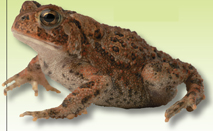The three orders of amphibians include more than 6000 species, roughly 5000 of which are frogs and toads.
URODELA: Salamanders and newts
Salamanders and newts have long bodies and tails. Most also have four legs. All are carnivores. Adults usually live in moist woods, where they tunnel under rocks and rotting logs. Some salamanders, such as the mud puppy, keep their gills as adults and live in water all their lives. Examples: Barred Tiger Salamander, Red Eft

Red Eft
ANURA: Frogs and toads
Adult frogs and toads are amphibians without tails that can jump. Frogs tend to have long legs and make long jumps, whereas toads have shorter legs that limit them to shorter hops. Frogs are generally more dependent on bodies of fresh water than toads, which may live in moist woods or even deserts. Examples: treefrogs, Leopard Frog, American Toad, spadefoot toads

American Toad
APODA: Caecilians
The least-known and most unusual amphibians are the legless caecilians. They have tentacles, and many have fishlike scales embedded in their skin—which shows that not all amphibians fit the general definition. Caecilians live in water or burrow in moist soil or sediment, feeding on small invertebrates such as termites. Examples: Ringed Caecilian, Yellow-Striped Caecilian

Ringed Caecilian

Because amphibian eggs must develop in water, most live in moist climates. Some, such as this Alpine Newt, live on cool, rainy mountain slopes.
Table of Contents
- Formulas and Equations
- Applying Formulas and Equations
- Mean, Median, and Mode
- Estimation
- Using Measurements in Calculations
- Effects of Measurement Errors
- Accuracy
- Precision
- Comparing Accuracy and Precision
- Significant Figures
- Calculating With Significant Figures
- Scientific Notation
- Calculating With Scientific Notation
- Dimensional Analysis
- Applying Dimensional Analysis




